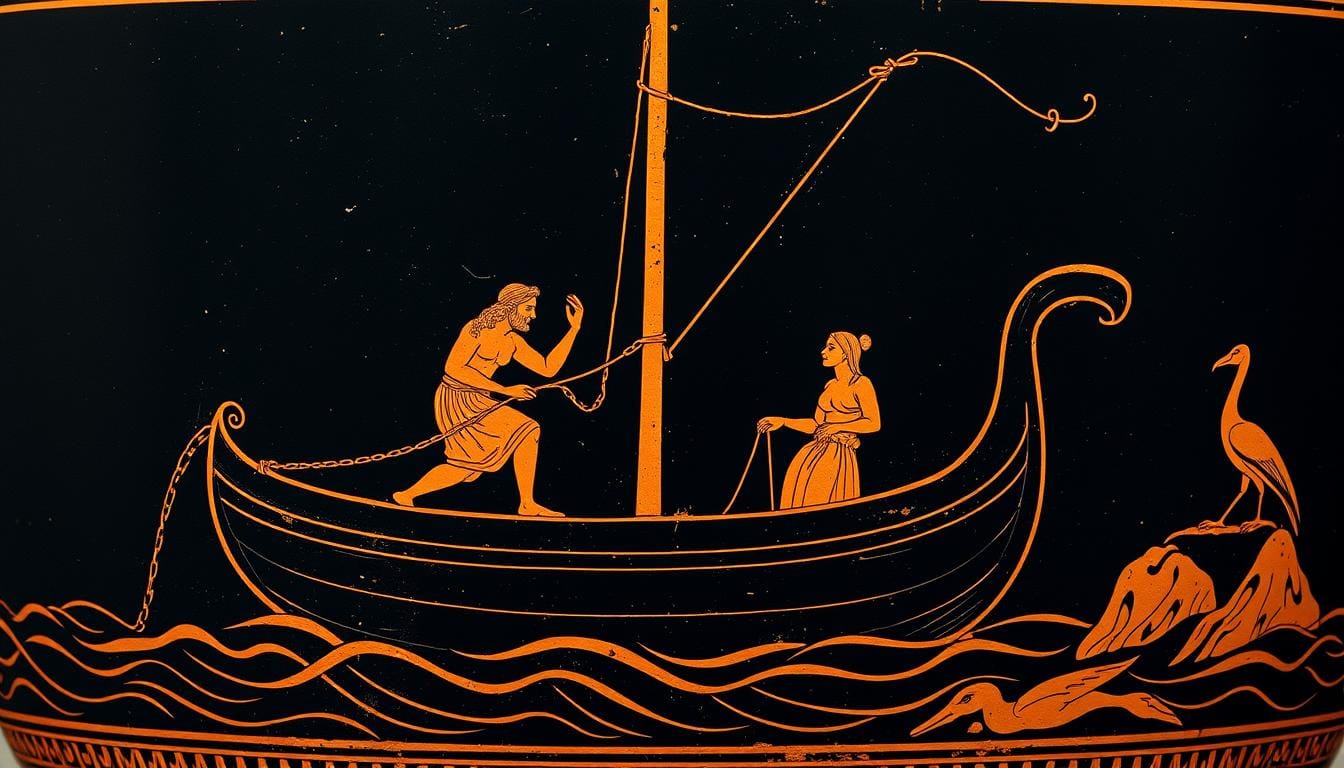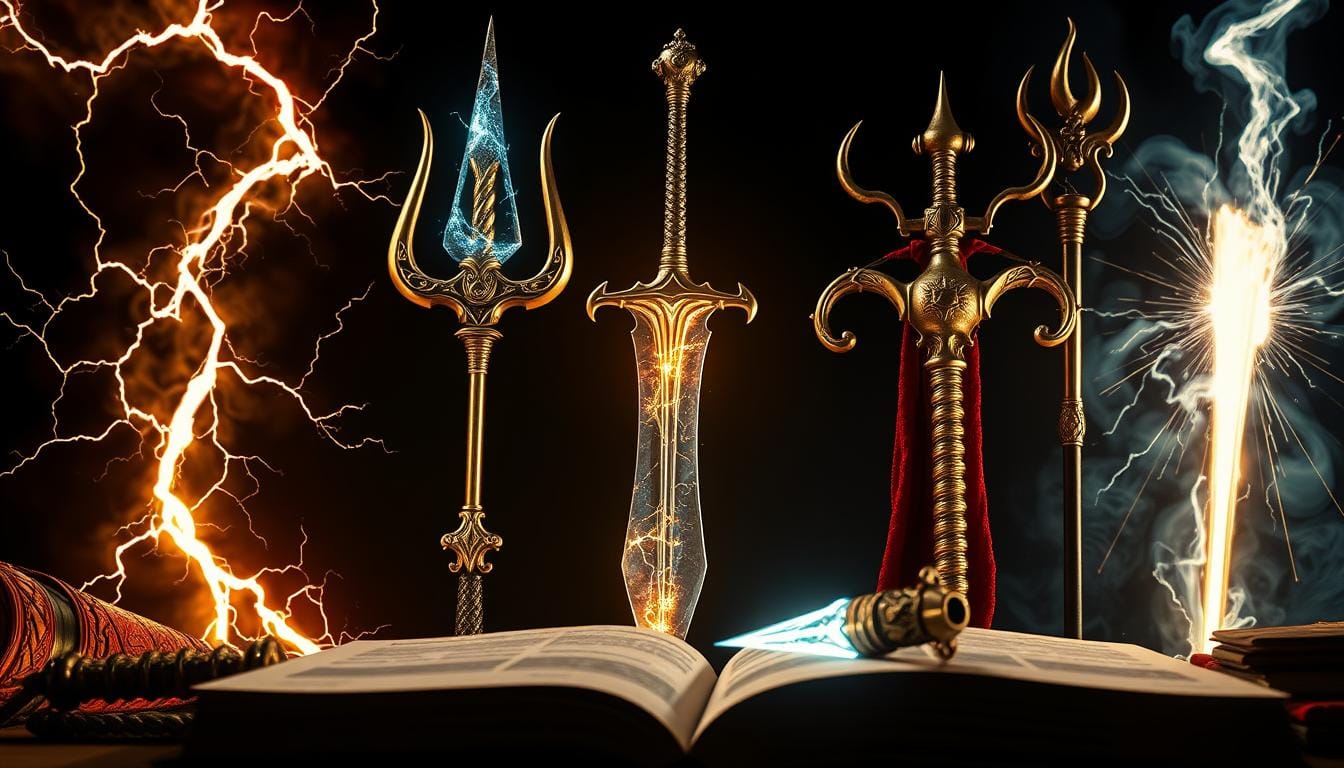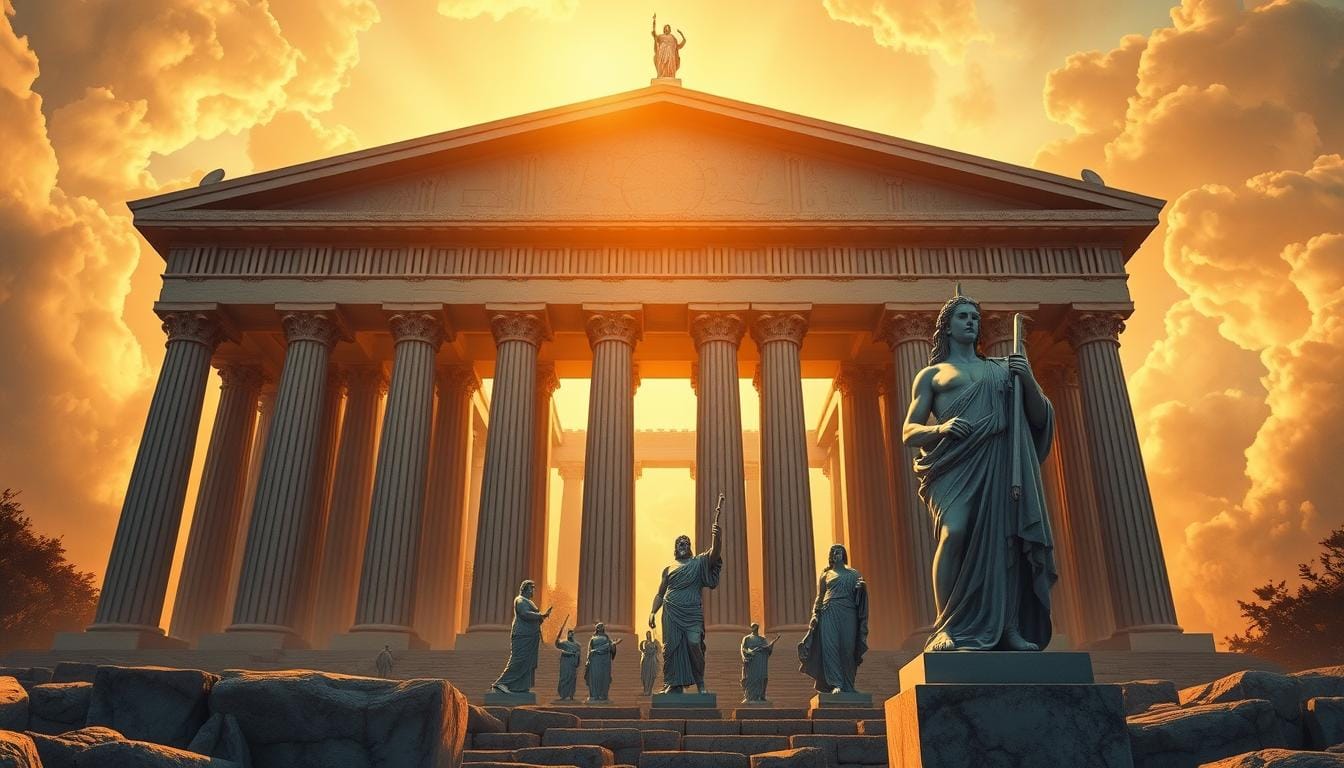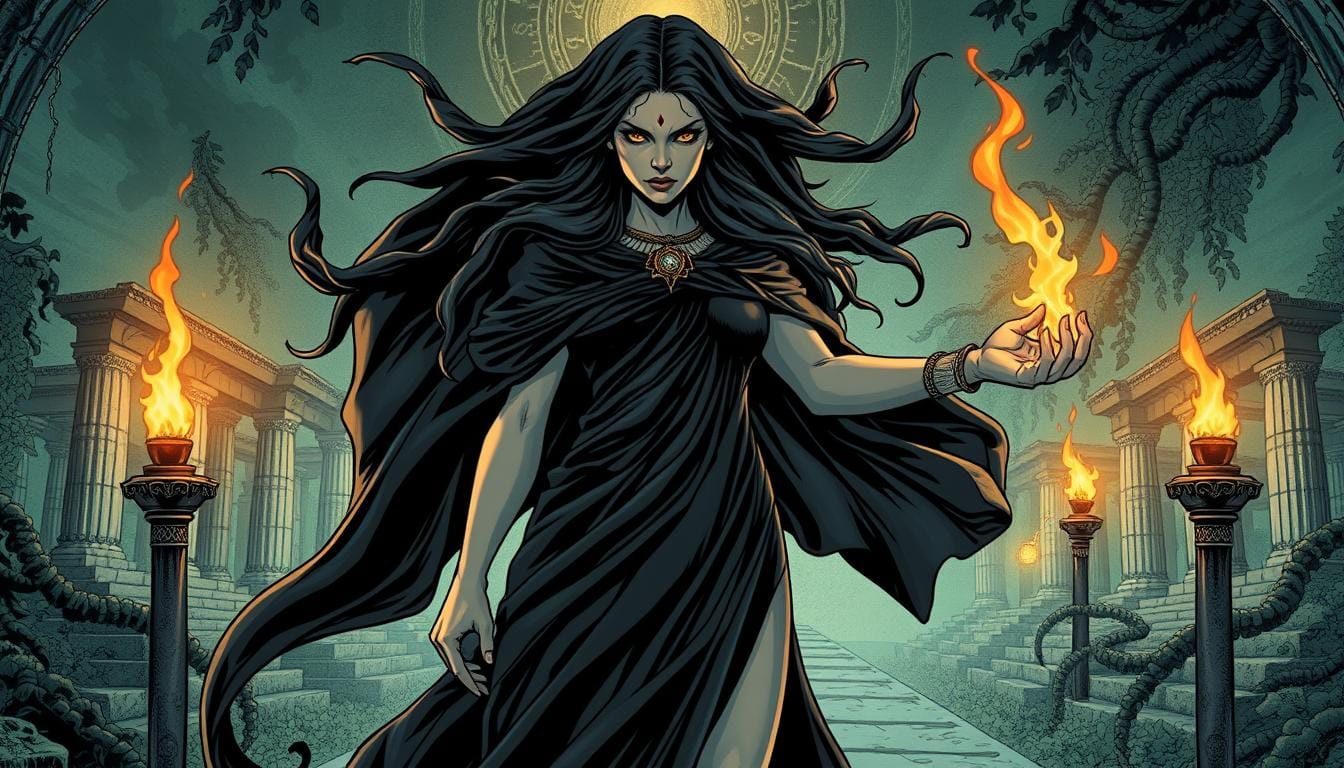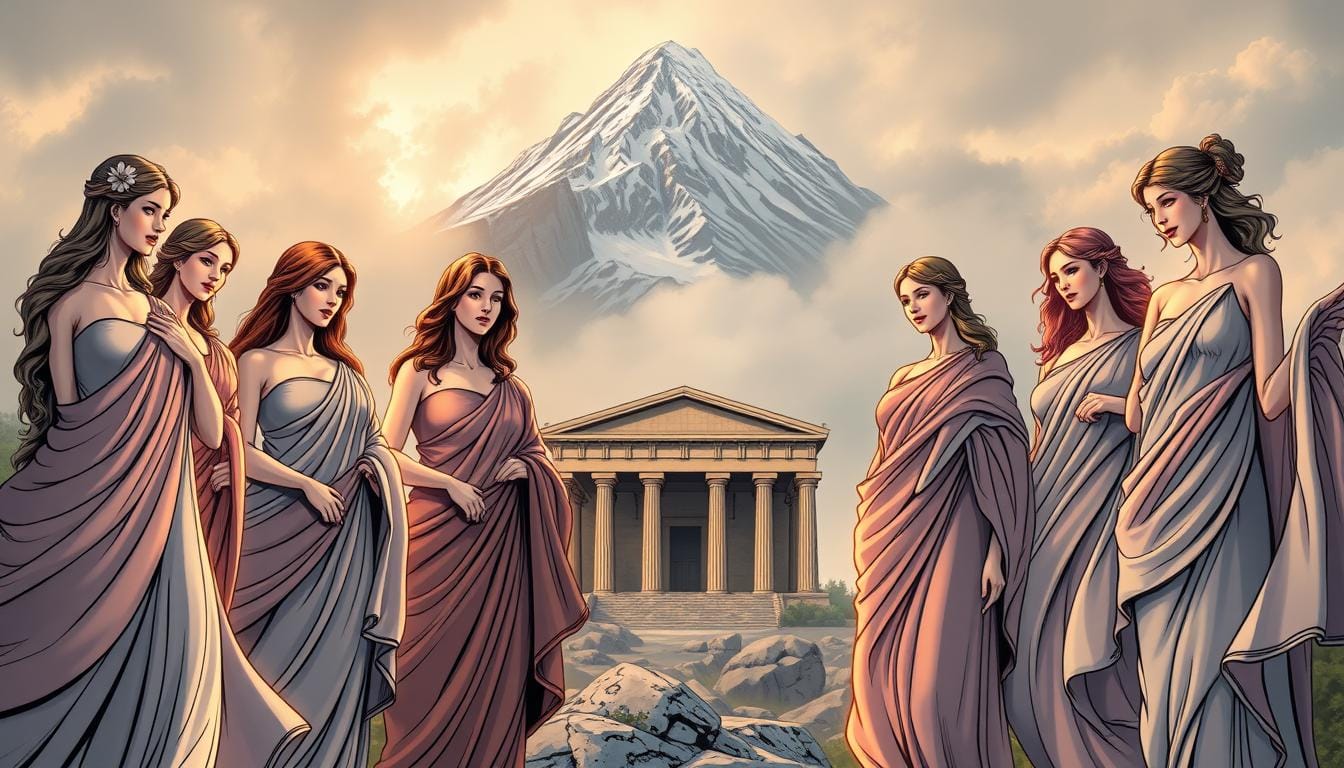The tale of Orpheus and Eurydice stands as one of the most poignant love stories in Greek mythology. This enduring narrative of devotion, music, and the fateful backward glance has captivated audiences for millennia. From ancient texts like Ovid’s Metamorphoses and Virgil’s Georgics to modern Broadway productions, the story of Orpheus and Eurydice continues to resonate with themes of love transcending death, the power of art, and the tragic consequences of doubt. Join us as we explore this timeless myth, its profound meanings, and its lasting cultural impact across the centuries.
Ancient depiction of Orpheus attempting to rescue Eurydice from the Underworld
Origins of the Orpheus and Eurydice Myth
The myth of Orpheus and Eurydice has ancient roots, though its earliest complete versions come from Roman rather than Greek sources. While references to Orpheus appear in earlier Greek texts, the full narrative of his journey to the Underworld to rescue his wife emerges most clearly in the works of Roman poets.
Virgil's Account
In Virgil’s Georgics (29 BCE), the story appears as a tragic epilogue to his poem about agriculture. Virgil emphasizes the “sudden madness” (dementia) that caused Orpheus to look back at Eurydice during their ascent from the Underworld. His version suggests this fatal mistake should be forgiven, portraying it as an understandable moment of weakness born from love.
Virgil writes of the moment when Orpheus loses Eurydice a second time: “A sudden madness took hold of the unwary lover, one to be forgiven, if the Manes knew how to forgive: he stopped, and forgetful, alas, on the edge of light, his resolve conquered, he looked back at his Eurydice.”
Ovid's Interpretation
Ovid’s version in Metamorphoses (8 CE), published a few decades after Virgil’s, offers a different perspective. Here, Eurydice’s initial death occurs while dancing with nymphs on her wedding day, rather than fleeing from Aristaeus. Ovid provides multiple possible motivations for Orpheus’s backward glance:
“Fearing she was failing, greedy to see her, out of love he turned back his eyes; and immediately she slipped back.” This complex explanation suggests Orpheus acted out of concern, desire, and love—making his mistake all the more human and relatable.

Orpheus charming animals with his divine music, a testament to his extraordinary musical talent
The Narrative of Orpheus and Eurydice
The story of Orpheus and Eurydice follows a clear narrative arc that has remained relatively consistent across various retellings throughout history. Let’s explore the key elements of this timeless tale.
Orpheus: The Divine Musician
Orpheus was the son of the Muse Calliope and, according to some accounts, the god Apollo. He possessed extraordinary musical talent—his lyre playing and singing were so beautiful that they could charm all living things. When Orpheus played, wild animals would gather peacefully, trees would bend their branches to listen, and even stones would move to be closer to his divine melodies.
The Tragic Death of Eurydice
Orpheus fell deeply in love with the beautiful nymph Eurydice, and they were happily married. However, their joy was short-lived. Shortly after their wedding, Eurydice was walking through a meadow when she was bitten by a venomous snake. In some versions, this happens while she’s fleeing from Aristaeus, a minor god who was pursuing her; in others, she simply steps on the snake while dancing with nymphs. Regardless of the circumstances, the poison quickly took effect, and Eurydice died, descending to the Underworld.

The tragic moment of Eurydice’s death by snakebite in a flowering meadow
The Descent to the Underworld
Devastated by grief, Orpheus decided to do what no living mortal had done before—journey to the Underworld to bring his beloved back. Armed only with his lyre, he descended through a cave that led to the realm of Hades. Along the way, he faced numerous challenges:
- He charmed Charon, the ferryman, to carry him across the River Styx
- He soothed Cerberus, the three-headed guard dog of the Underworld
- He moved past the souls of the dead who were drawn to his music
- He finally reached the thrones of Hades and Persephone, rulers of the Underworld
The Plea to Hades and Persephone
Standing before the rulers of the Underworld, Orpheus played his most moving melody and sang of his undying love for Eurydice. His music was so powerful that it affected even the emotionless shades of the dead. Sisyphus paused his eternal labor to listen. The Furies, tasked with punishing the wicked, wept for the first time. Even Hades and Persephone were moved by his performance and his plea.
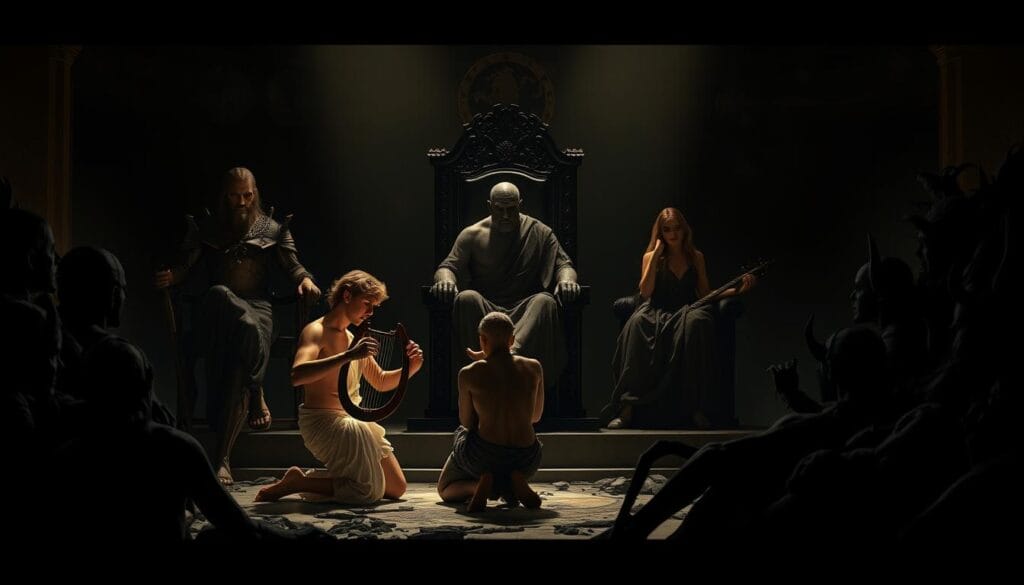
Orpheus pleading his case before Hades and Persephone with his heartbreaking music
The Fateful Condition
Moved by Orpheus’s music and his devotion, Hades agreed to release Eurydice on one condition: as they journeyed back to the world of the living, Orpheus must walk ahead of Eurydice and not look back at her until they had both reached the upper world. If he turned to look at her before they both reached the sunlight, she would be lost to him forever.
The Tragic Backward Glance
Orpheus accepted the condition and began the long ascent, with Eurydice following silently behind. As they neared the entrance to the living world, Orpheus became anxious. Unable to hear Eurydice’s footsteps (as she was still a shade), he began to doubt whether she was still following him or if the gods had tricked him. Just as they were about to reach the surface, overcome by love, doubt, or simply the desire to see his beloved again, Orpheus turned to look back at Eurydice.
In that instant, she was pulled back into the depths of the Underworld, reaching out to him as she faded away with a final “farewell.” Orpheus had failed, and Eurydice was lost to him a second time—this time forever.
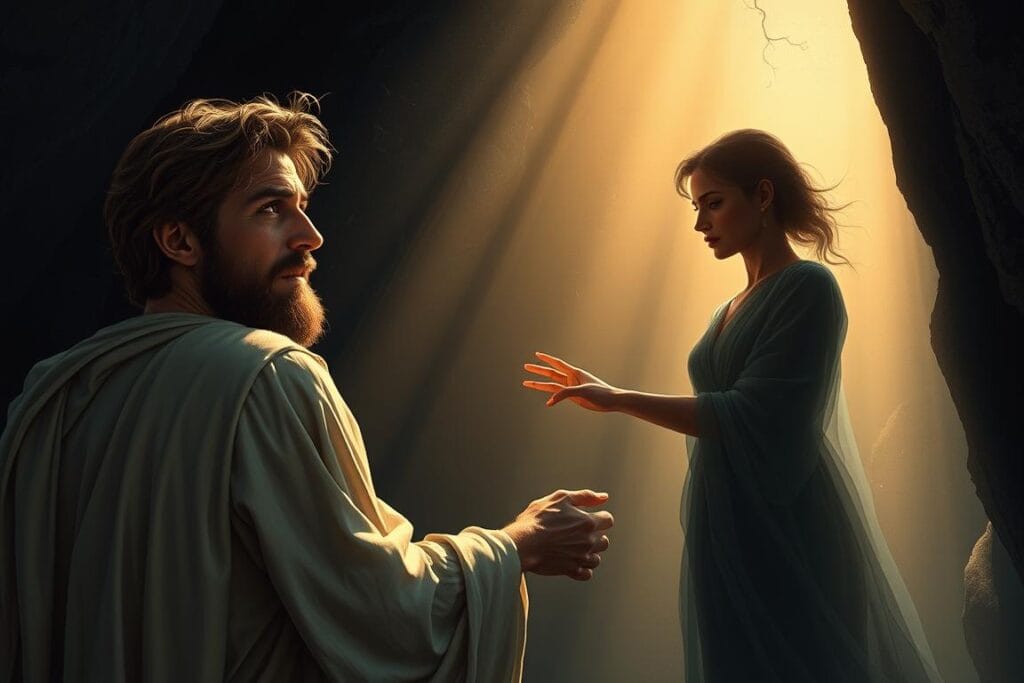
The tragic moment when Orpheus turned back, losing Eurydice forever
Deepen Your Knowledge of Greek Mythology
Want to explore more fascinating Greek myths? Subscribe to our monthly newsletter featuring stories, analyses, and cultural connections of ancient myths.
Key Themes in the Orpheus and Eurydice Myth
The enduring power of the Orpheus and Eurydice myth lies in its rich thematic content. For thousands of years, this story has resonated with audiences because it explores fundamental aspects of the human experience.
Love Transcending Death
At its core, this is a story about love’s power to challenge even the boundaries between life and death. Orpheus’s willingness to journey to the Underworld—a place no living person was meant to go—demonstrates the extraordinary lengths to which love can drive us. His music, fueled by this love, moves even the implacable rulers of the dead.
This theme speaks to our universal desire to believe that love is stronger than death—that true connection between souls cannot be severed even by mortality’s final curtain.
The Power of Art and Music
Orpheus’s music has the power to alter reality itself—calming wild beasts, moving stones, and even swaying the gods of the Underworld. This represents the transformative potential of art to cross boundaries, change hearts, and achieve what might otherwise seem impossible.
The myth suggests that artistic expression can reach places that nothing else can, touching the deepest parts of our humanity. Even in the realm of the dead, where all other human qualities fade, the beauty of music retains its power.
Doubt and Its Consequences
Perhaps the most poignant theme is how doubt undermines Orpheus’s quest at the final moment. Despite his extraordinary journey and apparent success, he cannot maintain faith in the unseen. His need for visual confirmation—to look back and verify Eurydice’s presence—becomes his undoing.
This aspect of the myth explores how doubt can sabotage our greatest achievements and deepest relationships, especially when we’re on the verge of success. It raises questions about trust, faith, and our ability to believe in what we cannot directly perceive.
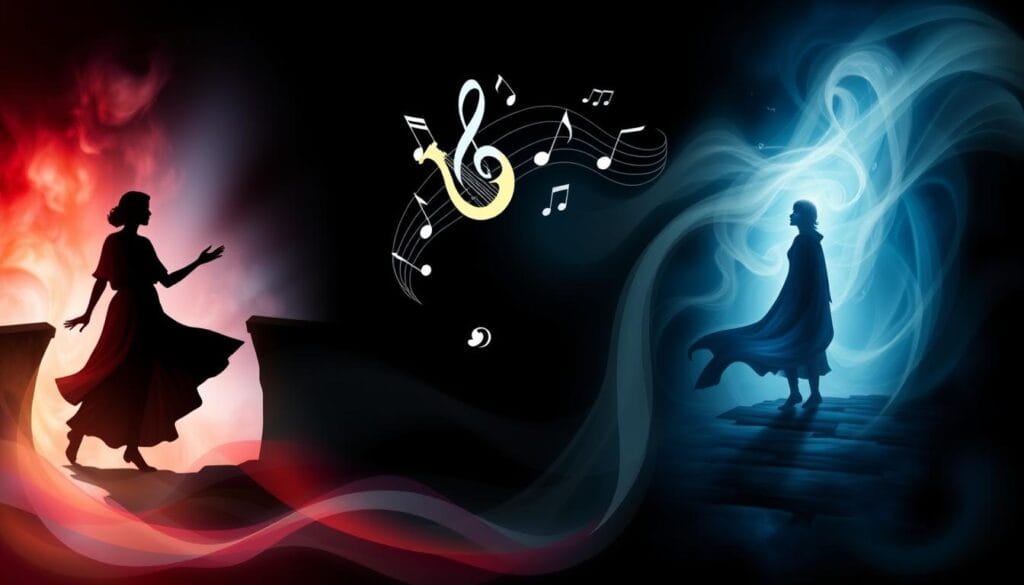
Artistic representation of the major themes in the Orpheus and Eurydice myth
Additional Thematic Elements
The Limits of Human Will
Despite Orpheus’s extraordinary determination and talent, he ultimately fails to change Eurydice’s fate. This speaks to the Greek concept of fate and the limitations of human agency against cosmic order. No matter how gifted or determined we may be, some boundaries cannot be crossed, and some losses must be accepted.
Looking Back vs. Moving Forward
The prohibition against looking back can be interpreted metaphorically as the need to move forward in life rather than dwelling on the past. Orpheus’s inability to resist looking backward becomes a powerful metaphor for the human struggle between honoring what we’ve lost and continuing our journey forward.
Cultural Impact of Orpheus and Eurydice
Few myths have inspired as many artistic interpretations across different media as the tale of Orpheus and Eurydice. From ancient times to the present day, this story has been continuously reimagined, reinterpreted, and retold, demonstrating its enduring resonance with human experience.
Musical Adaptations
Given Orpheus’s identity as the quintessential musician, it’s fitting that his story has inspired numerous musical works, particularly operas:
- Monteverdi’s L’Orfeo (1607) – Often considered the first great opera in music history, Monteverdi’s masterpiece established the Orpheus myth as ideal material for operatic treatment.
- Gluck’s Orfeo ed Euridice (1762) – This revolutionary work reformed opera by emphasizing dramatic truth over vocal display, featuring the famous “Melody of Mourning” aria.
- Offenbach’s Orpheus in the Underworld (1858) – A satirical operetta that parodies the myth, featuring the famous “Can-Can” dance.
- Anaïs Mitchell’s Hadestown (2010/2019) – This Tony Award-winning Broadway musical reimagines the myth in a Great Depression-inspired setting, addressing themes of economic hardship and environmental crisis alongside the original love story.

Scene from the Broadway production of Hadestown, a contemporary musical adaptation of the myth
Visual Arts
The dramatic moments of the myth have inspired painters and sculptors throughout history:
- Titian’s Orpheus and Eurydice (c. 1508) – One of the earliest Renaissance paintings of the subject
- Poussin’s Landscape with Orpheus and Eurydice (1650-1653) – Places the myth within an idealized classical landscape
- Rodin’s Orpheus and Eurydice sculpture (1893) – Captures the moment of their separation
- Klimt’s The Kiss (1907) – While not explicitly labeled as Orpheus and Eurydice, one interpretation sees this famous painting as depicting their story
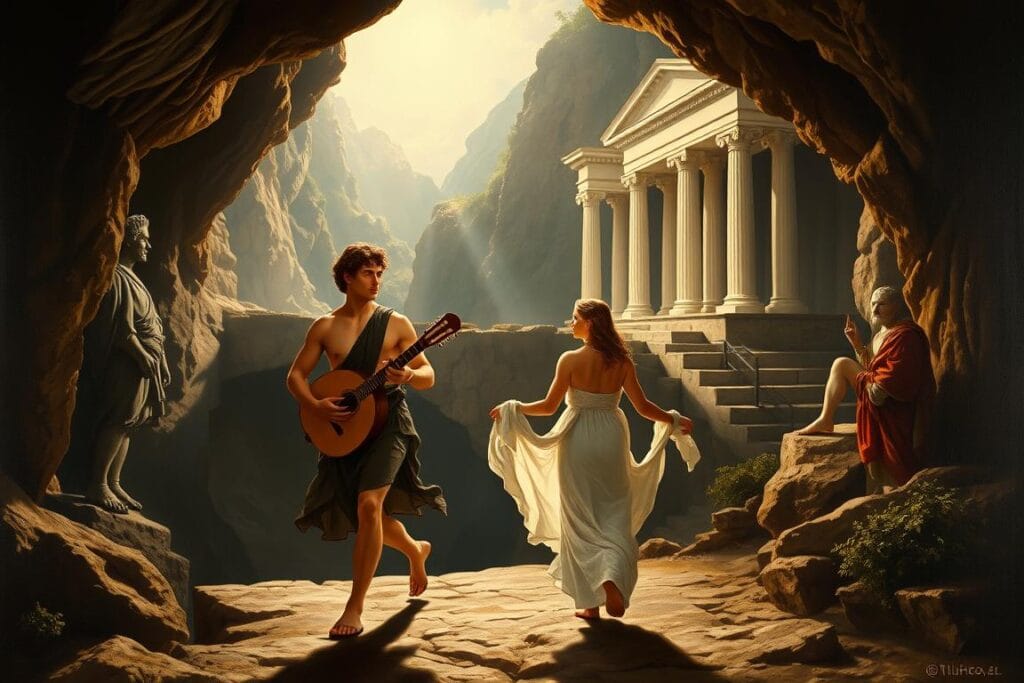
Classical painting depicting Orpheus leading Eurydice from the Underworld
Literature and Poetry
The myth has inspired countless literary works, with some of the most notable including:
- Rilke’s “Orpheus. Eurydice. Hermes” (1907) – A poem that reimagines the myth from all three perspectives, with particular attention to Eurydice’s experience
- Anouilh’s Eurydice (1941) – A play that transposes the myth to modern France
- Cocteau’s Orphic Trilogy (1930-1959) – A series of films that reimagine the myth in contemporary settings
- Sarah Ruhl’s Eurydice (2003) – A play that retells the story from Eurydice’s perspective, adding her father as a character in the Underworld
- Salman Rushdie’s The Ground Beneath Her Feet (1999) – A novel that reimagines Orpheus and Eurydice as rock musicians
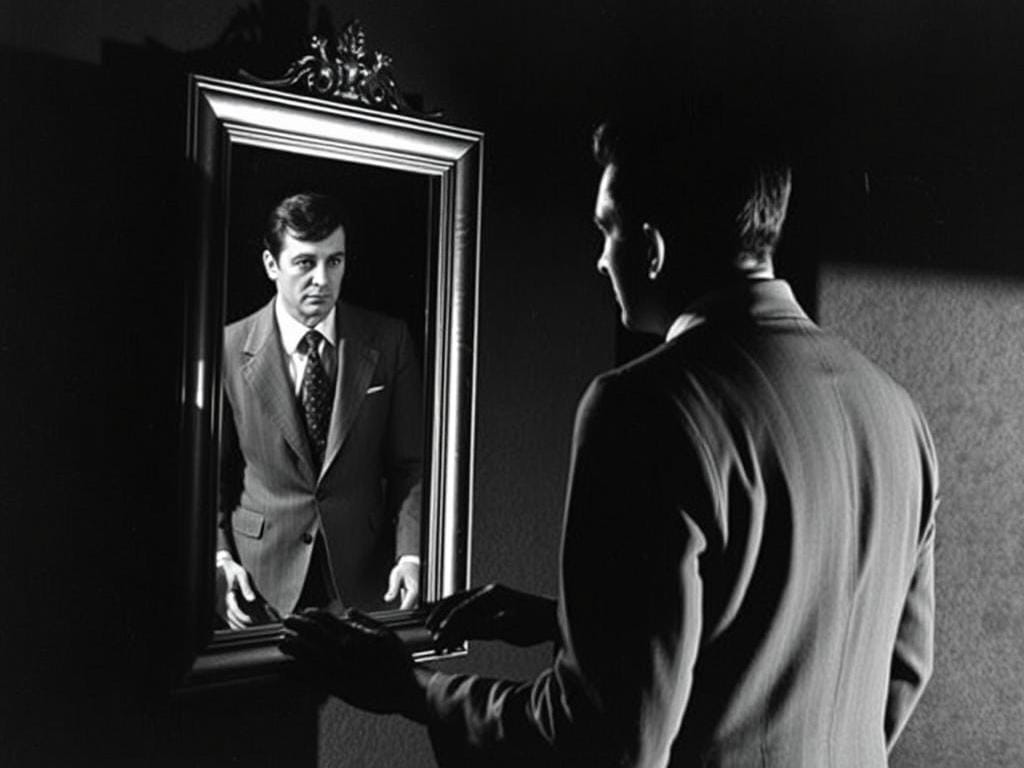
Still from Jean Cocteau’s film Orpheus (1950), a surrealist modern interpretation of the myth
Film and Theater
The cinematic and theatrical adaptations of the myth include:
- Marcel Camus’s Black Orpheus (1959) – Sets the story in the carnival of Rio de Janeiro
- Tennessee Williams’s Orpheus Descending (1957) – A play that transposes elements of the myth to the American South
- Jean Cocteau’s Orphée (1950) – A surrealist film set in post-war Paris
- Céline Sciamma’s Portrait of a Lady on Fire (2019) – Uses the myth as a thematic touchstone for its exploration of forbidden love and memory
Modern Interpretations and Psychological Symbolism
Beyond its artistic adaptations, the Orpheus and Eurydice myth has been subject to numerous psychological and philosophical interpretations that reveal its continued relevance to contemporary human experience.

Abstract representation of psychological interpretations of the myth
Psychological Perspectives
Jungian Analysis
From a Jungian perspective, Orpheus’s journey to the Underworld represents a descent into the unconscious mind. Eurydice symbolizes the anima (the feminine aspect of the male psyche), and Orpheus’s attempt to bring her back represents the integration of unconscious elements into conscious awareness. His failure—looking back—suggests the difficulty of this psychological integration.
Grief and Acceptance
Many modern interpretations view the myth as an allegory for the process of grief. Orpheus’s journey represents the desire to deny death and bring back the lost loved one. His backward glance symbolizes the moment when one must accept the reality of loss. The prohibition against looking back can be seen as the necessary psychological step of accepting death’s finality.
Feminist Reinterpretations
Contemporary feminist readings have questioned the traditional focus on Orpheus, noting that Eurydice is often reduced to a passive object of his quest rather than a subject with her own agency and experience. Modern adaptations like Sarah Ruhl’s play Eurydice and H.D.’s poem “Eurydice” shift the perspective to center Eurydice’s experience.
Some interpretations even suggest that Eurydice might not have wanted to return to life—that Orpheus’s quest was more about his needs than hers. This reading transforms the myth from a story about failed heroism to one about the importance of respecting others’ autonomy, even in love.
Philosophical Dimensions
Philosophers have found rich material in the myth:
- Maurice Blanchot saw in Orpheus’s backward glance the essential nature of artistic creation—the artist must confront the “impossible” and fail in order to create authentic work
- Albert Camus connected the myth to his concept of the absurd, seeing in Orpheus’s quest a metaphor for humanity’s struggle against meaninglessness
- Plato used the myth in his Symposium to criticize Orpheus for lacking the courage to die for love, suggesting that true love requires ultimate sacrifice
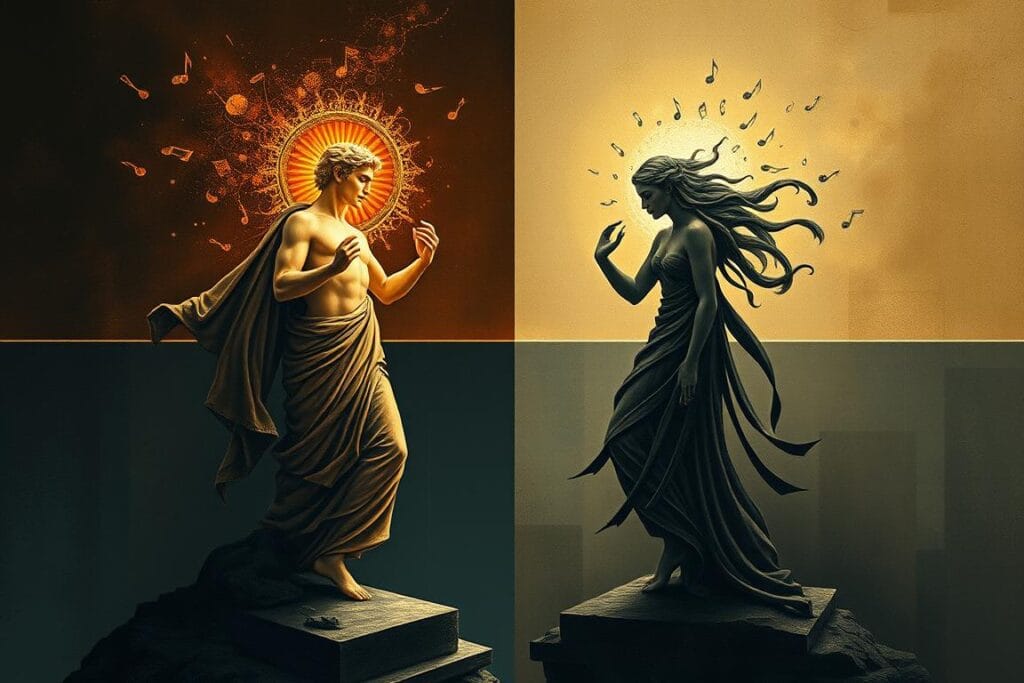
Modern artistic interpretation showing the myth as a psychological journey
Why This Myth Still Resonates Today
Despite its ancient origins, the myth of Orpheus and Eurydice continues to speak powerfully to contemporary audiences. Its enduring relevance stems from several factors:
Universal Emotional Experience
The myth addresses universal human experiences: love, loss, grief, and the desire to defy death. Everyone who has loved and lost can relate to Orpheus’s desperate wish to bring back what is gone. His journey to the Underworld represents the lengths to which we might go to avoid facing the permanence of death.
The Power and Limits of Art
In an age where we often look to art and creativity for meaning and transcendence, Orpheus represents both the extraordinary power of artistic expression and its ultimate limitations. His music can move the gods themselves, yet it cannot permanently alter the fundamental laws of existence.
The Human Tendency to Sabotage Success
Orpheus’s fatal backward glance—occurring just moments before success—resonates with the very human tendency to undermine our own achievements at the critical moment. This psychological truth makes the myth feel as relevant today as it was thousands of years ago.

Contemporary artwork illustrating the timeless connection between the ancient myth and modern human experience
Contemporary Relevance
Modern adaptations like Anaïs Mitchell’s Hadestown demonstrate how the myth can be reimagined to address contemporary concerns. By setting the story against a backdrop of climate change and economic inequality, Mitchell shows how ancient myths can help us process current challenges.
The story’s exploration of boundaries—between life and death, past and future, trust and doubt—speaks to our ongoing struggle with limitations and our desire to transcend them. In a world increasingly concerned with pushing boundaries through technology, the myth offers a nuanced meditation on the consequences of such ambitions.
The Myth as a Mirror
Perhaps most importantly, the myth of Orpheus and Eurydice functions as a mirror in which each generation can see its own reflection. The story’s ambiguity—particularly around why Orpheus looked back—allows for endless reinterpretation. Was it doubt? Impatience? Love? Fear? Each answer reveals something about the interpreter and their cultural moment.
This openness to interpretation ensures that the myth remains alive, continuing to generate new meanings and insights as our understanding of love, art, death, and human psychology evolves.
Explore the World of Greek Mythology
Deepen your understanding of ancient myths and their modern significance with our comprehensive guide to Greek mythology. Download it now to discover the stories, symbols, and lasting cultural impact of these timeless tales.
Conclusion: The Eternal Echo of Orpheus's Song
The myth of Orpheus and Eurydice has endured for millennia because it speaks to something fundamental in the human experience. It explores the tension between our greatest aspirations and our inevitable limitations, between our desire to transcend death and our inability to escape its reality.
Through countless retellings and reinterpretations—from ancient Roman poetry to Broadway musicals—the story continues to evolve while maintaining its essential power. It reminds us that love, art, and the human spirit can achieve extraordinary things, even if they cannot ultimately overcome the boundaries that define our existence.
Like Orpheus’s music, which continued to echo even after his death, this myth continues to resonate across time, inviting each new generation to find meaning in its haunting melody. As we face our own losses, create our own art, and navigate our own boundaries between past and future, the story of Orpheus and Eurydice offers both comfort and challenge—a reminder of both what we can achieve through love and creativity, and what we must ultimately accept.
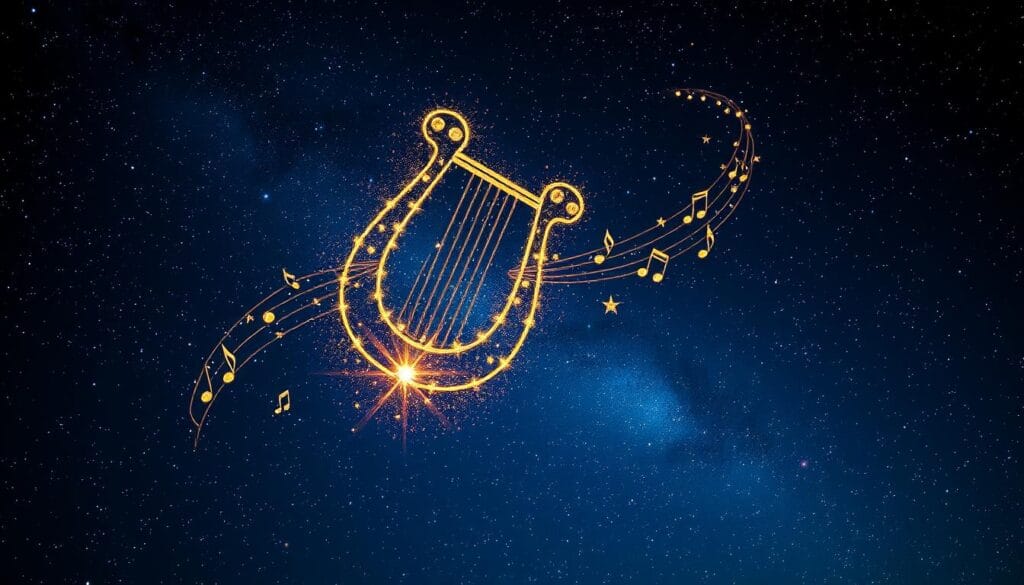
Orpheus’s lyre among the stars, symbolizing how his music and story continue to echo through time
